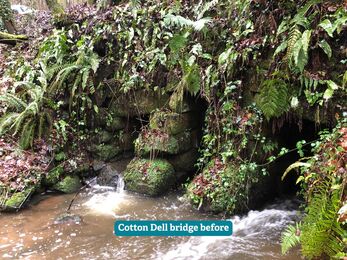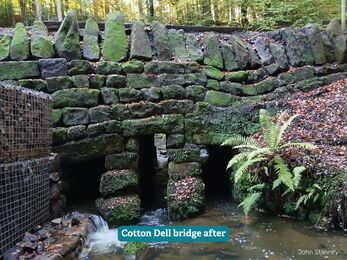Cotton Dell is part of a historic landscape, and this bridge is part of its heritage. We’re proud that thanks to this grant we’ve been able to restore it in the way it was originally constructed all those years ago.Staffordshire Wildlife Trust
Crumbling 18th century bridge restored to former glory
The bridge dates back to the late 1700s when the Churnet Valley was one of the hotbeds of the Industrial Revolution due to the copper-rich bedrock found there.
The bridge is special because it’s made using a dry stone construction technique. This means it was created skillfully by hand, with no mortar or cement holding the stones together, just weight and gravity.
Over time some of the stones had moved, and a landslip had caused further damage. The bridge was at risk of collapse if nothing was done.
Work to repair the bridge was completed thanks to funding from the Derbyshire Environmental Trust, funds raised by supporters of Leek Local Group for SWT, and a donation from a generous local resident. Repair work is now complete, and the bridge is safeguarded for the future.
Lucy O’Toole, Nature Reserves Manager at SWT, said: “The bridge is centuries old yet it isn’t listed or protected in any way. As guardians of this place it was important we didn’t allow this relic to be lost.
“Cotton Dell is part of a historic landscape, and this bridge is part of its heritage. We’re proud that thanks to this grant we’ve been able to restore it in the way it was originally constructed all those years ago.”
Malcolm Lawler, Head of Strategic Planning & Geology of Tarmac, said: “We’re proud to play a part in restoring this historic 18th-century bridge, a landmark that has connected people for generations. Its dry stone construction reflects the skill and dedication of those who built it by hand, without mortar or cement - just precision and gravity. Preserving this piece of heritage is about more than history; it’s about keeping our shared spaces alive for the community today and for generations to come.”



